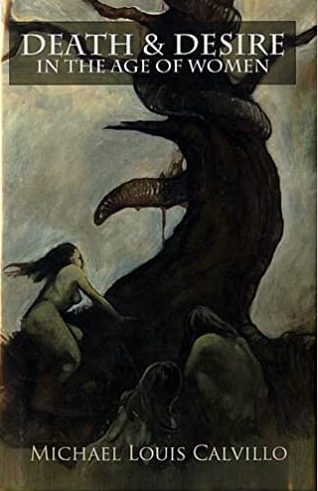 By MICHAEL LOUIS CALVILLO (Morning Star; 2011)
By MICHAEL LOUIS CALVILLO (Morning Star; 2011)
In this, his second publication of 2011 (following the novella BLEED FOR YOU), the late Michael Louis Calvillo has created a bold and idiosyncratic fictional riff on the concept of female empowerment. DEATH AND DESIRE IN THE AGE OF WOMEN isn’t quite as accomplished as Calvillo’s previous novels I WILL RISE and AS FATE WOULD HAVE IT, which were complex and multi-faceted in a way this highly literal-minded effort isn’t; on the other hand, it must be said that DEATH AND DESIRE very nearly equals its forerunners, and just about any other recent novel, in provocation and manic invention.
This novel will be—and has been—compared with Jack Ketchum’s LADIES’ NIGHT. For those unfamiliar with that 1997 publication, it concerns a chemical released into the air that turns women into psychotic killers. Calvillo’s novel is similarly themed, but unlike the highly problematic LADIES’ NIGHT, DEATH AND DESIRE… provides a compellingly bizarre rationale for its mayhem in the form of a telepathic worm that appears to women in a dream one night, followed by mass menstruation the following morning—which comes to be known as Bloody Tuesday. Calvillo’s novel also boasts an exceedingly well-imagined female-dominated world that arises after the women of the world, under the worm’s telepathic influence, rise up against the males.
The focus is on Victor and Claudia, a happily married couple who like everybody else on Earth are irrevocably impacted by the worm. Claudia brutally kills her young son(!) during the worm-instigated uprising while Victor manages to elude the homicidal females around him—initially at least. He’s eventually caught and incarcerated together with several other male survivors, while Claudia is put to work in the new worm-dominated world, run by different stratifications of brainwashed women (meaning some gals are more affected by the worm than others).
But Claudia longs to see her husband again and for things to go back to the way they were before Bloody Tuesday. She arranges a clandestine meeting with Victor, who will have to be broken out of prison; that’s a good thing, as Victor isn’t doing too well behind bars, having incited the wrath of a highly influential psychopath who calls himself The Baron (after the floating villain of DUNE).
Things unfortunately don’t work out as you might hope for Victor and Claudia. To his credit, Calvillo provides little in the way of reassurance: in this novel love does not conquer all and the ending is far from happy. Calvillo sustains the nastiness of the early scenes throughout, never selling out his concept and leaving things on a decidedly tangled and unresolved note. The issues explored in DEATH AND DESIRE IN THE AGE OF WOMEN are thorny ones that have vexed mankind for centuries, and are here given a fictional treatment that feels entirely appropriate.
